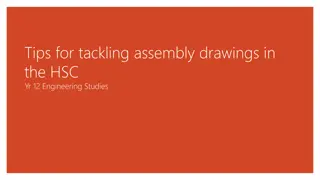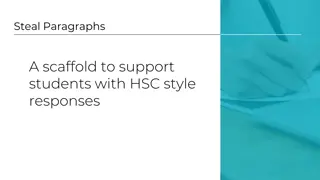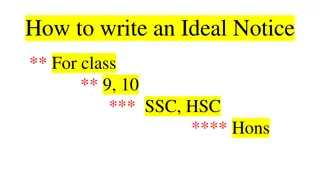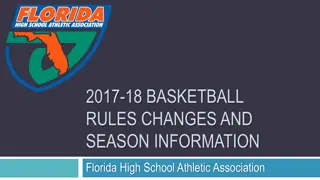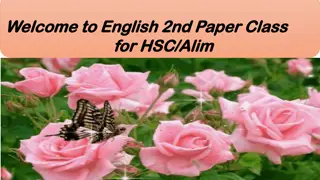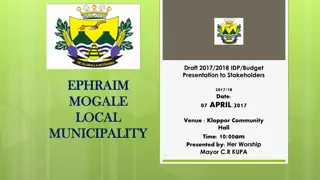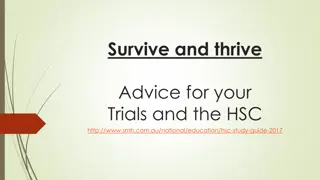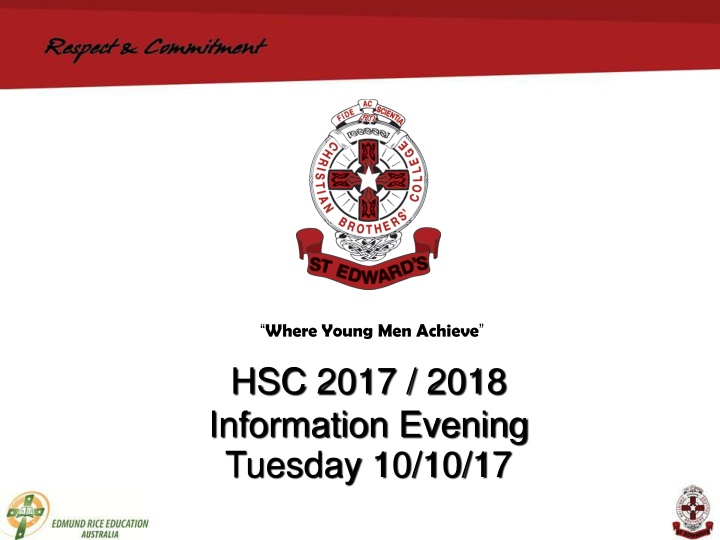
Achieving Success in HSC 2017/2018: Key Information & Documentation
Explore all you need to know about Higher School Certificate (HSC) 2017/2018, including assessment marks, examination criteria, performance bands, course reports, and the AQF VET Certificate. Understand how students are evaluated against standards and receive valuable insights for potential employers.
Download Presentation

Please find below an Image/Link to download the presentation.
The content on the website is provided AS IS for your information and personal use only. It may not be sold, licensed, or shared on other websites without obtaining consent from the author. If you encounter any issues during the download, it is possible that the publisher has removed the file from their server.
You are allowed to download the files provided on this website for personal or commercial use, subject to the condition that they are used lawfully. All files are the property of their respective owners.
The content on the website is provided AS IS for your information and personal use only. It may not be sold, licensed, or shared on other websites without obtaining consent from the author.
E N D
Presentation Transcript
Where Young Men Achieve HSC 2017 / 2018 Information Evening Tuesday 10/10/17
HSC DOCUMENTATION At the completion of Year 12 you will receive Individual course reports. Higher School Certificate Record Of Achievement. Higher School Certificate. Students studying VET Courses also receive a Statement of Attainment.
Higher School Certificate Record of Achievement Assessment mark - Schools submit an HSC assessment mark based on performance in school assessment tasks for every student in every course. Examination mark - the examination mark for each course shows the student's performance in the Board's HSC examination for that course. HSC mark - the HSC mark is a 50:50 combination of a student's external examination mark and school- based assessment mark for each course. Performance band - a student's HSC mark for each course will fall within one of six performance bands, where the highest achievement is Band 6 (90 100) and where the minimum standard expected is 50.
Course Reports Students receive an HSC course report for each course with an external examination that has been completed satisfactorily. The course report shows the student's assessment mark, examination mark, HSC mark and performance band with a description of what a student within that band typically knows, understands and can do.
AQF VET Certificate This certificate is awarded to students in Vocational Education and Training (VET) courses who successfully complete all requirements of an Australian Qualifications Framework VET Certificate.
The Student Portfolio School Certificate and HSC reports, and workplace records and references Information for employers in assessing your suitability
Marks reflect standards achieved Each student is assessed against known standards, as well as receiving their position in the course All students who reach the minimum standard will receive a mark of 50 No predetermined number of students in each mark range. No limit on the number of students achieving top marks.
EXTENSION COURSES Have a maximum possible mark of 50 Are reported in relation to four performance bands: E1, E2, E3, E4 Have band cut off marks of: Band 4 -45 Band 3 -35 Band 2 -25
Why use assessment tasks as part of the HSC Course? Using assessment tasks allows teachers to measure student achievement in all aspects of the course. Takes into account aspects which cannot be measured in a formal exam; eg practical or oral skills Takes away the pressure from just having one exam
When does HSC assessment begin? HSC Course assessment begins in term 4 of year 11 and ends towards the end of term 3 year 12. HSC Course assessment will only begin if Preliminary course work has been completed. The assessment policies and procedures booklet outlines the amount, type and timing of each task for each HSC course.
What are the rules regarding completion of tasks? Task must be submitted on time or a penalty of 20% per day late is applied. Absence from or failure to submit a task requires a medical certificate (for sickness) or other documentation (for reasons other than sickness) You must phone the college on the morning of the task to notify the teacher of your impending absence.
ASSESSMENT Rules (continued) You must obtain and complete an illness and misadventure form on the day you return to school. Students must complete assessment tasks that total more than 50% of total assessment otherwise they do not receive the HSC
ASSESSMENT Rules (continued) Tasks completed outside of class must be the students own work. Teachers will check that this is the case. (HSC All My Own Work) Students completing assessment tasks on computer are encouraged to regularly print out their most recent work. Computer malfunction is not a grounds for misadventure Special provisions are available for assessment tasks. Students need to inform the learning support team well in advance of their intention to use special provisions.
ASSESSMENT IN VET COURSES In all VET courses students are assessed on their ability to perform a variety of different competencies. The Board of Studies does not require an assessment mark from the school at the end of the HSC. If a student wishes to use a VET course in the calculation of an ATAR (Australian Tertiary Admissions Rank) he must sit for the HSC exam. The school is required to provide an estimated mark to the Board of studies and this is only used in the event of illness or misadventure on the day of the exam. The estimated mark provided to the Board of Studies is the students result in the Trial HSC Examination.
VET ASSESSMENT Rules continued VET students (Hospitality, Metals and Engineering, Sports Coaching, Construction and Entertainment) on work placement have the following responsibilities: 1. Find out from each of your teachers the work to be completed while you are on work placement. 2. If an assessment task is due while you are on work placement you must negotiate with your class teacher when you will hand in / complete the task.
Australian Tertiary Admission Rank (ATAR) In 2009, the Universities Admissions Index (UAI) changed to the Australian Tertiary Admission Rank (ATAR). The maximum ATAR is now 99.95 (as opposed to a maximum UAI of 100). Achieving an ATAR of 99.95 is the same as achieving a UAI of 100. Rules for the ATAR are the same as for the UAI. There will be no changes to: scaling process, rank order of students, student selection for university courses
Australian Tertiary Admission Rank (ATAR) Other criteria such as a portfolio, interview, audition, questionnaire or test may also be taken into account in conjunction with the ATAR for certain courses. Calculation of the ATAR is the responsibility of the University Admissions Centre (UAC) not the Board of Studies
ATAR Calculation The best 10 units of marks from Board Developed courses are used to calculate this mark. Included in this mark are: - 2 units of English - At most 2 units of Category B subjects (Construction, Hospitality, Entertainment, Metals and Engineering, and TVET Courses) English Studies, although a board developed course, does not contribute in the calculation of the ATAR. Board Endorsed Courses are not used in calculating the ATAR (Photography, Sports Coaching, Catholic Studies and Mathematics General 1.)
Raw Moderated Exam + Assessment Marks Raw Moderated Exam + Assessment Marks Board of Studies Board of Studies Universities Admissions Centre Universities Admissions Centre The scaled mark for each course is based on the quality of the candidates in that course in that year Scaled Scaled 2 units of English + next best 8 units 2 units of English + next best 8 units ATAR ATAR
The middle ranked students in the cohort receive an ATAR of around 66.00 Recent trends have indicated that middle-placed HSC students received HSC marks in the 70s, whereas middle-ranking ATAR s have remained in the 60s.
HSC is for all students the HSC presents a profile of student achievement across a broad range of subjects ATAR is for students wishing to gain a place at a university (approximately 30% achieve a place in their first year after leaving school) the ATAR is an index used to rank school leavers for tertiary places. It does not summarise 13 years of schooling Pathways The ATAR is limited to one of the many pathways open to school leavers with the HSC
Where Young Men Achieve HSC 2017 / 2018 Information Evening Tuesday 10/10/17
ATAR ESTIMATOR Username: 13fred Password: College17
ATAR RULES The best 10 units of marks from Board Developed courses are used to calculate this mark. Included in this mark are: - 2 units of English - At most 2 units of Category B subjects (Construction, Hospitality, Entertainment, Metals & Engineering, TVET Courses) Board Endorsed Courses are not used in calculating the ATAR. (Photography, Sports Coaching, Religion-school course)
Sample ATAR Cut-offs- University Courses 2016 Australian Catholic University B Ed (Primary) 60.00 B Teach/ B Arts (Sec Maths) B Theology/ B Philosophy B Arts B Commerce B Exercise and Sport Science B Laws Charles Sturt University (Albury, Bathurst, Dubbo, Orange, Wagga Wagga) B Business (Marketing) B Education (Primary) B Exercise and Sports Science B Physiotherapy B Applied Science (Parks& Rec) B Business Studies B Arts B Business (Management) B Animal Science 60.00 58.50 58.50 58.50 59.00 81.65 65.00 70.00 70.00 85.10 70.00 65.00 65.00 65.00 70.00 Available from the University Admissions Centre Website
Planning for success 1. The sort of tertiary courses I would like to consider have a ATAR between . and .. 2. To achieve the goal ATAR I think I might need to 3. The two courses I am most confident about are .. 4. The course I am having most difficulty with is............ 5. The course I could probably improve in most easily is 6. The best way for me to concentrate on getting the marks in Assessment tasks and the HSC exams I want this year would be to
Planning for success Teachers are keen to help Ask for feedback what do I have to do to improve? Start Assessment tasks early and seek feedback. Work conscientiously and consistently in class. Do the revision that teachers set. Work out a way of doing your own revision. Ask your teachers how to go about this revision. Look for help to plan how to go about Assessment tasks and exam preparation.

